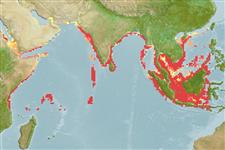Environment: milieu / climate zone / depth range / distribution range
Écologie
marin benthopélagique; profondeur ? - 60 m (Ref. 114953). Tropical; 28°N - 10°S, 33°E - 120°E (Ref. 114953)
Indo-West Pacific: Red Sea, India (including Sri Lanka) to Indonesia, north to Japan (Ref. 114953). Australian and old records from the Mediterranean Sea and Suriname need confirmation.
Taille / Poids / Âge
Maturity: Lm ? range ? - ? cm
Max length : 300 cm TL mâle / non sexé; (Ref. 58048)
Found inshore (Ref. 9909) and offshore (Ref. 58784). A carnivorous fish that feeds on large shellfishes (Ref. 58784). Ovoviviparous (Ref. 50449). Biology little known (Ref. 9909). Caught occasionally by demersal tangle net fisheries operating throughout the area. Utilized for its meat, find (both very high value), skin and cartilage (Ref.58048). Marketed fresh and probably dried-salted (Ref. 9909).
Life cycle and mating behavior
Maturities | Reproduction | Spawnings | Egg(s) | Fecundities | Larves
Exhibit ovoviparity (aplacental viviparity), with embryos feeding initially on yolk, then receiving additional nourishment from the mother by indirect absorption of uterine fluid enriched with mucus, fat or protein through specialised structures (Ref. 50449).
Compagno, L.J.V., 1999. Checklist of living elasmobranchs. p. 471-498. In W.C. Hamlett (ed.) Sharks, skates, and rays: the biology of elasmobranch fishes. Johns Hopkins University Press, Maryland. (Ref. 35766)
Statut dans la liste rouge de l'IUCN (Ref. 130435)
Menace pour l'homme
Harmless
Utilisations par l'homme
Pêcheries: commercial
Outils
Articles particuliers
Télécharger en XML
Sources Internet
Estimates based on models
Preferred temperature (Ref.
123201): 24.8 - 29.1, mean 28.1 °C (based on 1958 cells).
Phylogenetic diversity index (Ref.
82804): PD
50 = 0.5156 [Uniqueness, from 0.5 = low to 2.0 = high].
Bayesian length-weight: a=0.00372 (0.00145 - 0.00950), b=3.09 (2.87 - 3.31), in cm total length, based on LWR estimates for this (Sub)family-body shape (Ref.
93245).
Niveau trophique (Ref.
69278): 3.5 ±0.37 se; based on food items.
Résilience (Ref.
120179): Faible, temps minimum de doublement de population : 4,5 à 14 années (Fec assumed to be <100).
Fishing Vulnerability (Ref.
59153): Very high vulnerability (90 of 100).
